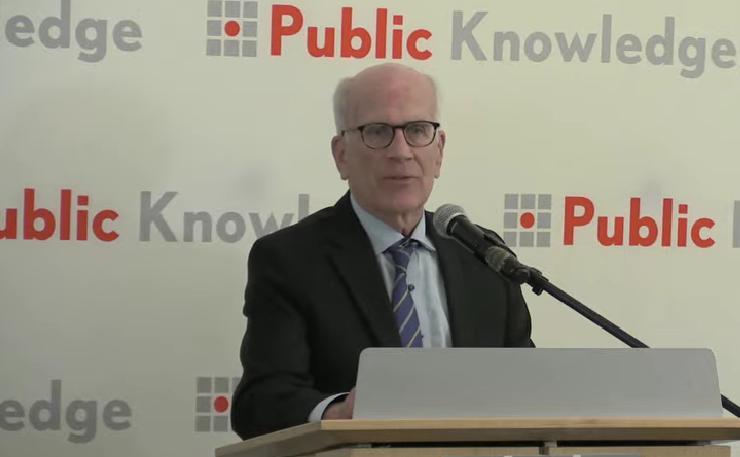NFTs May Be Central to the Emerging ‘Internet of Value,’ Say Experts at Pulver VON3
Bringing back transaction costs for messages or phone calls may be a way to deter spam messages.

February 3, 2022 – The explosion of interest in non-fungible tokens — digital assets of unique internet content — is a result of, and an important player in, the next phase of the evolution of the internet, according to technology experts.
More companies are entering the so-called metaverse, a virtual world that mimics the real world, where real social interactions happen through avatars. Facebook has rebranded to become Meta in an effort to get ahead of this evolution, and Microsoft’s proposed purchase of Activision-Blizzard is to also be in part a proposal to get its foot into the metaverse.
But another relatively recent development in the space is the creation digital memorabilia known as non-fungible tokens, which are purchased and sold through no intermediary — that is, no payment processing company or bank gets involved in the transaction.
The way it works is that users enter a marketplace that features listings for these digital assets, which can be a digitized news item or even a memorable tweet from social media platform Twitter. The users will have a digital wallet that will store the items and will have a purse for cryptocurrencies, which are themselves on a decentralized ledger known as the blockchain.
When a transaction is made, all users of the blockchain will have a copy of the deal. This process is said to make fraud difficult, as opposed to a centralized ledger that would keep all deals on one system, keeping eyes of those not involved off transactions.
The development and increasing acceptance of these assets — and the move toward the metaverse largely — are what experts at The VON3 Summit last month are calling the next phase, the third big cycle, in the internet’s evolution.
In this third phase, the internet is focused on communities and users having control of their creative assets, unencumbered by large technology companies and banks trying to get a slice of them through transaction fees and the like.
“Web1 was a promise of an open internet. Web2 was a promise of social connection. Web3 is a promise of creative content ownership,” said Jeremy Lipschultz, a professor at University of Nebraska Omaha and participant of the conference.
Jeff Pulver, founder and host of The VON3 Summit, declared that Web3 is the “dawn of a new era of the internet.” He said, “Web2 is really about companies, products and then community, and Web3 has a characteristic that is community first.”
By selling, gifting, redeeming or trading NFTs through the blockchain, in other words, creators have complete control of their content and who has access to it, the summit heard.
‘Internet of Value’
Web 3 has been coined by some of Pulver’s contemporaries as the “Internet of Value” because individuals will have complete control of all their assets on the internet without an intermediary. This new reality would mean that the economic world we know today would completely shift, say proponents.
“The tools are there, the value to be created is there, it requires one thing: Imagination,” said Pulver.
Non-fungible tokens are the reason Web 3 could be critical to the creative community, the summit heard. NFTs are defined by Bret Kinsella, VON3 panelist and founder and CEO of Voicebot.ai, as the “bridge between Web 2 and Web 3.”
Beyond creativity, NFTs could also be the future of nonprofits and charities. Carole Baskin from Big Cats Rescue has used the power of NFTs to raise money that will save large cats like tigers and lions around the world. Even wineries are trying to get involved, said Jacob Ner David, CEO of one called Vinsent.
As pioneers discover and decide what is possible for NFTs as a result of Web3, Pulver was quick to remind listeners that “this is new for all of us. We’re in this together.”
Users owning their data
Jeremiah Owyang, an industry analyst based in Silicon Valley and one of the speakers at the conference, said that in the ideal Web3, “we can own our data, we can own our identities, and we can own our equity.”
Instead of internet platforms taking users’ data and making money from that, the users would have ownership and control over that data.
“That’s the vision,” said Owyang.
This vision was shared by other speakers, such as the co-founder and co-chair of location technology company Foursquare, Dennis Crowley. He said that while it would be the user’s choice what to do with their own information, maybe we, as users, would be able to “hold onto some of the value [of our data] and monetize them.”
Bringing back micropayments?
This vision also tied into an idea of Koji CEO Dmitry Shaprio: Bringing back transaction costs for messages or phone calls as a way to deter spam messages and robocalls.
Lower costs for voice and data communications have been a godsend for many. But the fact that there is no charge (beyond access to an internet service provider) to send email messages led in the early internet to the proliferation of spam.
More recently, the widespread use of digital telephony and a U.S. regulatory system in which termination charges have been eliminated for cellular calls has led some to appreciate the value that toll charges impose in ensuring that the communicators aren’t scamming recipients of their messages.
Or as Shaprio put it, “Want to send me a message? Pay the price.”
Chris Fine, a technologist and business leader, also emphasized the value of time, saying that in Web3, there should be “some way to filter” the messages and calls received.
Pulver agreed. “Pay me for my time,” he said.
Theadora Soter contributed reporting to this article.








